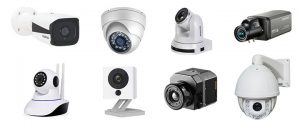
The purpose of a security camera is to surveil or monitor your home. The devices are quite useful in fending off thieves and burglars. In fact, the very presence of a security camera is often enough to stop a criminal and make them think twice about their life choices.
However, if and when a crime does occur on your property, the security camera will record the activity so that you can use it for evidence. Video footage is hard evidence, and it can be helpful in a number of scenarios when seeking insurance compensation, restoration, and even justice.
Security cameras are ubiquitous today, as they are sold by most home security companies. They will be advertised for either indoor or outdoor use; though anytime you see “indoor/outdoor,” that simply means the camera is built for pretty much any conditions.
Also, they come in hardwired or wireless options. A more permanent solution for property surveillance is the hardwired camera. On the other hand, wireless cameras are typically DIY and can be set up and functioning in a matter of minutes.
With many home security cameras, you can choose to sign-up for 24/7 professional monitoring, or choose to monitor the security camera yourself. More homeowners are opting for this “self-monitoring” option, as today’s cameras make it easy to remotely view your property via the camera’s companion app.
Many camera systems will actually send a text alert when activity is detected in or around your home. You then simply hop on the app and see exactly what the camera sees, and of course, either call the police on the perpetrator, or open the door because it’s just the pizza guy (after all, cold pizza is a crime).
Most home security cameras are built to withstand the elements, so you can rest assured your home is protected when it’s raining, hailing, snowing, etc. Also, the image quality on today’s cameras is impressive to say the least. Many offer full-HD imaging with 1080p resolution, night vision, the works.
Whether you choose to outfit your home with a single security camera at your entryway, or set up multiple cameras to cover every nook and cranny of your home, you have options galore. Today’s home security cameras can come stacked with anything up to and including:
- Wireless technology (battery operated)
- Smart home compatibility
- Easy, DIY installation
- Mobile alerts and connectivity
- Durable, weatherproof equipment
- Free cloud storage (in some cases)
- Facial recognition features
- Two-way communication
- Voice response
- And more
You can see why security cameras are becoming more popular. But… they aren’t a perfect solution. One disadvantage is that static cameras don’t pan or tilt to get the whole picture of a person. Another disadvantage, specific to wireless cameras, is that the batteries can run out of juice fairly quickly. So that’s something you should always keep in mind if you go wireless.
Finally, one last disadvantage of (Wi-Fi) home security cameras and monitors is that they can be hacked into by criminals. While the hardwired cameras can be bypassed by a cord-snipping burglar. Cases like these are rare, and rest assured there are measures you can take to safeguard against these criminal acts.
All in all, it’s a smart call to purchase one or several high-quality home security cameras. Because you can never be too safe.

every post is very informative for your health ..